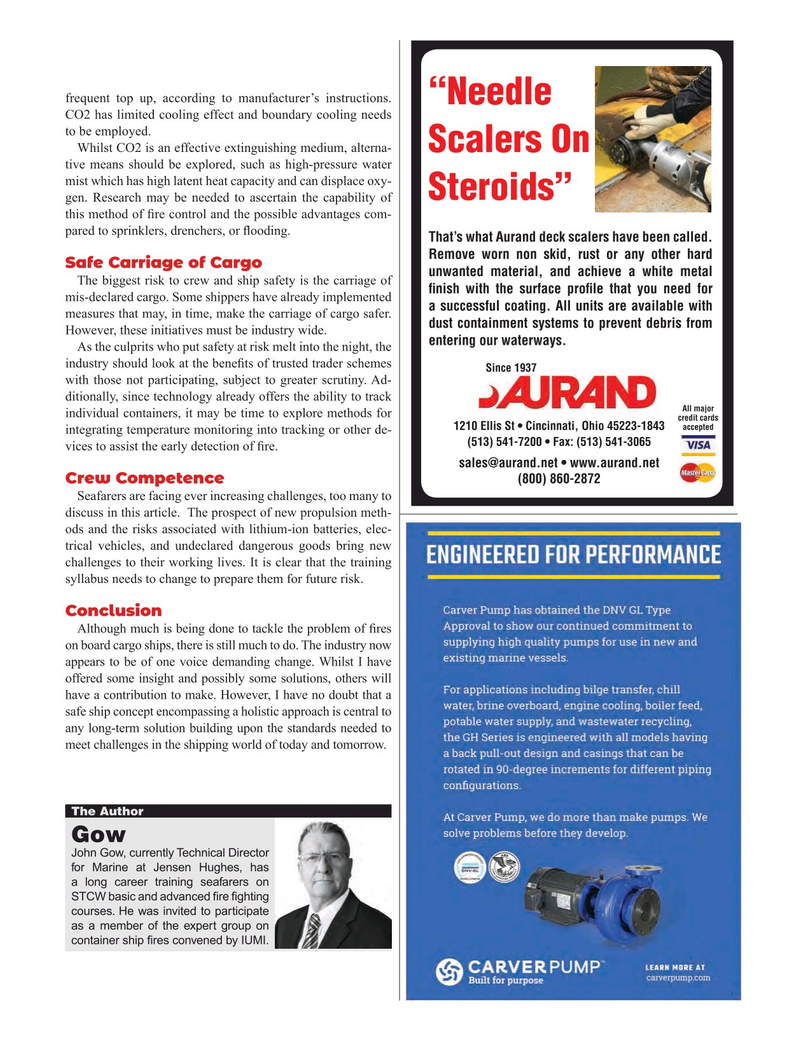
Page 33: of Maritime Reporter Magazine (November 2022)
The Workboat Edition
Read this page in Pdf, Flash or Html5 edition of November 2022 Maritime Reporter Magazine
frequent top up, according to manufacturer’s instructions. “Needle
CO2 has limited cooling effect and boundary cooling needs to be employed.
Whilst CO2 is an effective extinguishing medium, alterna-
Scalers On tive means should be explored, such as high-pressure water mist which has high latent heat capacity and can displace oxy-
Steroids” gen. Research may be needed to ascertain the capability of this method of ? re control and the possible advantages com- pared to sprinklers, drenchers, or ? ooding.
That’s what Aurand deck scalers have been called.
Remove worn non skid, rust or any other hard
Safe Carriage of Cargo unwanted material, and achieve a white metal
The biggest risk to crew and ship safety is the carriage of ? nish with the surface pro? le that you need for mis-declared cargo. Some shippers have already implemented a successful coating. All units are available with measures that may, in time, make the carriage of cargo safer. dust containment systems to prevent debris from
However, these initiatives must be industry wide. entering our waterways.
As the culprits who put safety at risk melt into the night, the industry should look at the bene? ts of trusted trader schemes
Since 1937 with those not participating, subject to greater scrutiny. Ad- ditionally, since technology already offers the ability to track
All major individual containers, it may be time to explore methods for credit cards accepted 1210 Ellis St • Cincinnati, Ohio 45223-1843 integrating temperature monitoring into tracking or other de- (513) 541-7200 • Fax: (513) 541-3065 vices to assist the early detection of ? re.
[email protected] • www.aurand.net (800) 860-2872
Crew Competence
Seafarers are facing ever increasing challenges, too many to discuss in this article. The prospect of new propulsion meth- ods and the risks associated with lithium-ion batteries, elec- trical vehicles, and undeclared dangerous goods bring new challenges to their working lives. It is clear that the training syllabus needs to change to prepare them for future risk.
Conclusion
Although much is being done to tackle the problem of ? res on board cargo ships, there is still much to do. The industry now appears to be of one voice demanding change. Whilst I have offered some insight and possibly some solutions, others will have a contribution to make. However, I have no doubt that a safe ship concept encompassing a holistic approach is central to any long-term solution building upon the standards needed to meet challenges in the shipping world of today and tomorrow.
The Author
Gow
John Gow, currently Technical Director for Marine at Jensen Hughes, has a long career training seafarers on
STCW basic and advanced ? re ? ghting courses. He was invited to participate as a member of the expert group on container ship ? res convened by IUMI.
MR #11 (18-33).indd 33 11/3/2022 10:28:22 AM

 32
32

 34
34
